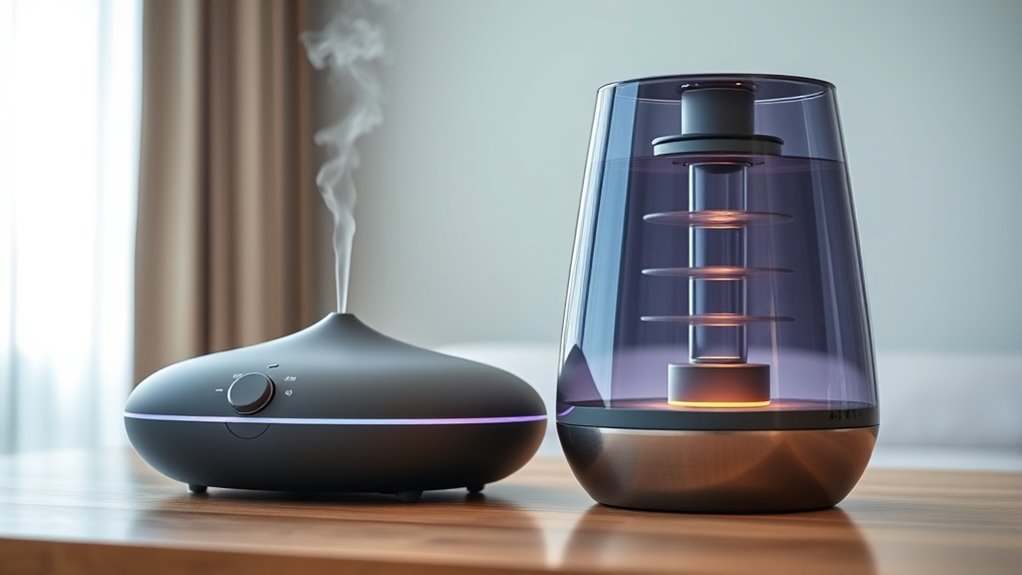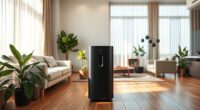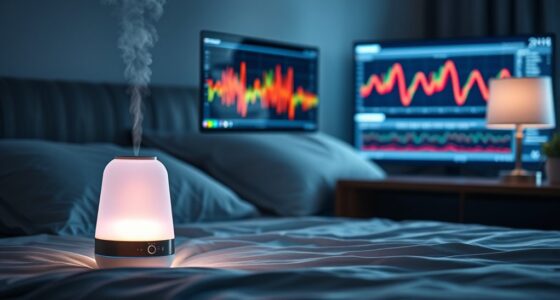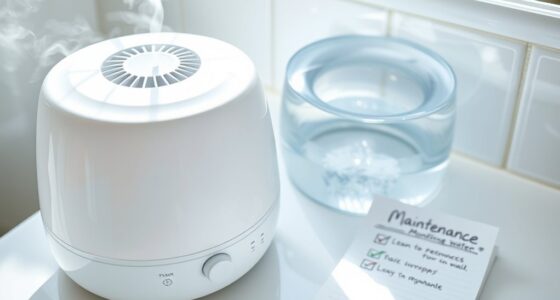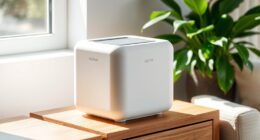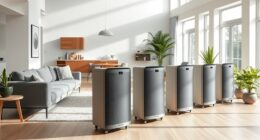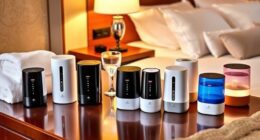Choosing between ultrasonic and evaporative humidifiers depends on your needs. Ultrasonic models are quiet, energy-efficient, and produce fine mist quickly, making them ideal for bedrooms. Evaporative units naturally regulate humidity, are budget-friendly, and better at filtering dust in larger spaces. Consider noise levels, maintenance, and air quality. For a clearer picture tailored to your home environment, explore how each type works and their pros and cons.
Key Takeaways
- Ultrasonic humidifiers are energy-efficient, operate quietly, and produce fine mist quickly, ideal for bedrooms and quiet spaces.
- Evaporative humidifiers naturally regulate humidity, are budget-friendly, and work well in larger, ventilated areas.
- Ultrasonic models may emit mineral dust without proper filtration, while evaporative units require regular cleaning to prevent mold.
- Both types need regular maintenance; ultrasonic units often need filter replacements, and evaporative models require tank cleaning.
- Choose based on room size, noise sensitivity, air quality needs, and maintenance preferences for the best home humidification.
How Ultrasonic and Evaporative Humidifiers Work
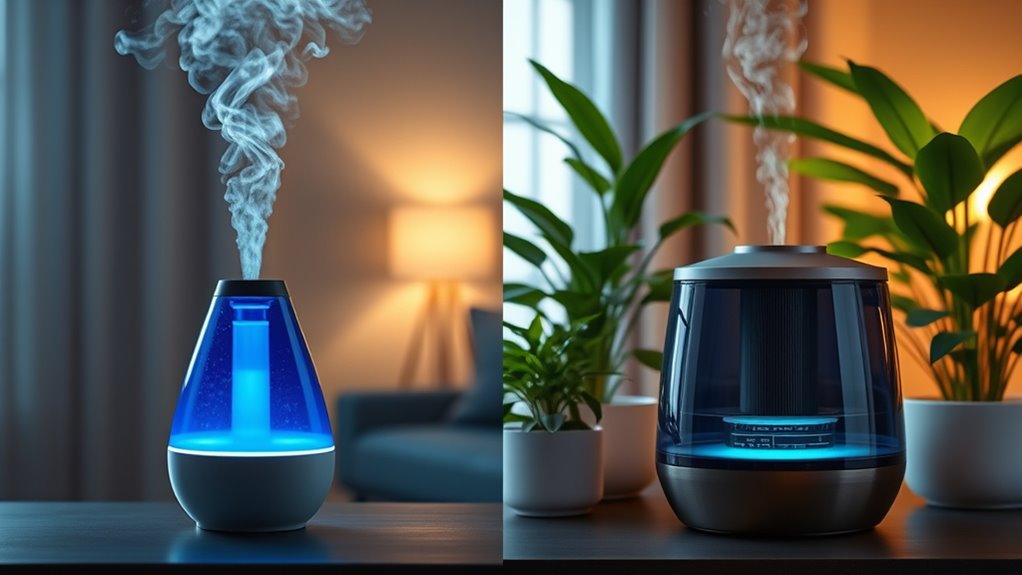
Ultrasonic and evaporative humidifiers operate differently to add moisture to the air. Ultrasonic models use high-frequency vibrations to produce a fine mist, which disperses into the room quickly. This method generally requires less energy, making ultrasonic humidifiers more energy-efficient. They can help improve air quality by maintaining consistent humidity levels without creating excess heat or noise. Evaporative humidifiers work by drawing air through a moistened wick filter, causing water to evaporate naturally into the air. This process helps regulate humidity levels automatically, which can be beneficial for air quality. While evaporative units tend to use more energy due to the fan needed for airflow, they often provide a more self-regulating and reliable humidity control. Additionally, AI-powered safety measures are increasingly being integrated into modern humidifiers to enhance user safety and device reliability. Both types influence air quality differently, depending on their design and operation.
Benefits of Ultrasonic Humidifiers

One of the main advantages of ultrasonic humidifiers is their energy efficiency; they use high-frequency vibrations to create a fine mist, which requires less power than other types. This makes them cost-effective and environmentally friendly. Ultrasonic humidifiers help improve air quality by adding moisture without dispersing minerals or bacteria, especially if you use purified water. This can reduce respiratory irritation and support better breathing, offering clear health benefits. Their quiet operation means you can use them overnight or in quiet spaces without disturbance. Additionally, their compact size and ease of maintenance make them suitable for various rooms. Moreover, choosing best heat pump models can further enhance your home’s climate control by providing consistent heating and cooling throughout the year. Overall, ultrasonic humidifiers provide an effective, energy-efficient way to enhance your indoor air quality and promote healthier living conditions.
Advantages of Evaporative Humidifiers

Evaporative humidifiers use a natural process to add moisture to the air, making them simple and effective. They also tend to be more budget-friendly to run and maintain. Plus, they operate more quietly, so they don’t disturb your daily activities. Additionally, their low input lag ensures consistent performance without delays.
Natural Humidification Process
Because evaporative humidifiers mimic the natural way moisture enters the air, they offer a straightforward and efficient method of humidification. They draw in dry air, pass it through a wetted wick or filter, and release moist air back into your space, maintaining a plant-based moisture source. This process helps you achieve a consistent humidity balance without over-humidifying. Unlike other methods, evaporative systems adjust automatically to room conditions, reflecting how nature naturally adds moisture. This natural process prevents excess humidity and supports a healthier indoor environment. Additionally, evaporative humidifiers are often more energy-efficient compared to other types, making them a practical choice for continuous use.
Cost-Effective Operation
Evaporative humidifiers not only mimic natural moisture entry but also stand out for their affordability and low operating costs. They are highly energy-efficient, helping you save on electricity bills over time. Because they rely on a simple, passive process, they require less maintenance and have fewer parts that could break down, which can reduce repair expenses. Their design minimizes energy consumption, making them a cost-effective choice for continuous use. Additionally, because they are among the best rated animated movies, they often appeal to a wide audience, ensuring you get value for your money. These factors make evaporative humidifiers an economical option, especially if you’re looking to balance performance with budget considerations. Their cost-effective operation ensures you enjoy consistent humidity without draining your wallet.
Reduced Noise Levels
One of the key benefits of evaporative humidifiers is their ability to operate quietly, making them ideal for bedrooms, offices, and other spaces where peace is essential. Their quiet operation results in minimal noise, allowing you to relax or focus without distraction. Unlike ultrasonic models that can produce high-frequency sounds, evaporative humidifiers naturally maintain noise reduction through their simple fan and wick system. This quiet operation ensures a peaceful environment, especially during sleep or work hours. If you value a device that works efficiently without disturbing your daily routine, evaporative humidifiers are a great choice. Their reduced noise levels contribute markedly to a calm, comfortable space, making them preferable for anyone seeking quiet comfort. Additionally, their design often incorporates water purification mechanisms that help maintain air quality while keeping noise levels low.
Potential Drawbacks of Each Type

Both ultrasonic and evaporative humidifiers have their downsides you should consider. Ultrasonic models can be noisy and may emit fine mineral dust if the water isn’t filtered properly, while evaporative units can be loud and require regular cleaning to prevent mold. Understanding these potential issues helps you choose the right humidifier for your needs. Additionally, filter replacement is essential for maintaining optimal performance and air quality in both types.
Noise Levels and Disruptions
While ultrasonic humidifiers are often praised for their quiet operation, they can sometimes produce a high-pitched buzzing or whine that disrupts sleep or concentration. This noise may cause sleep disturbances or annoy sensitive ears, especially during the night. Additionally, the sound can be distracting if you’re working or studying nearby. For pet owners, noise levels matter because loud or unexpected sounds can stress animals or interfere with their comfort and safety. It’s important to take into account how the hum might impact everyone in your home. Some units also emit a faint whine that’s hard to ignore over time. To minimize disruptions, choose models with sound ratings or consider placement strategies. Being aware of these noise-related drawbacks helps ensure your humidifier doesn’t compromise your peace or pet safety. Considering the integration of AI in device design could lead to quieter operation in future models.
Mineral Dust Emissions
Ultrasonic humidifiers and evaporative models each have their own concerns when it comes to mineral dust emissions. Ultrasonic units often produce fine mineral dust because they rely on high-frequency vibrations to create mist, which can aerosolize mineral particles from tap water. These dust particles may settle on furniture or be inhaled, potentially causing respiratory irritation. Evaporative humidifiers generally emit less mineral dust, as they use a wick or filter to trap minerals before releasing moisture. However, if the filter isn’t maintained properly, mineral dust can still escape into the air. In both cases, the presence of mineral dust can reduce air quality and create extra cleaning tasks. To minimize dust emissions, using distilled or filtered water is highly recommended, regardless of the humidifier type. Additionally, understanding the role of minerals in tap water can help you make informed decisions about water treatment options to reduce dust production.
Maintenance Challenges
Maintenance challenges can be a significant drawback for humidifier users, as each type requires regular upkeep to prevent issues. Ultrasonic models need frequent filter replacement to maintain efficiency and prevent mineral buildup, which can lead to white dust or device malfunction. Evaporative humidifiers demand thorough cleaning to prevent mold growth and ensure proper operation. Both types require diligent mold prevention measures, including regular cleaning of water tanks and components. Neglecting maintenance can cause bacterial growth, reduce air quality, and damage the unit. Staying on top of these tasks helps extend your humidifier’s lifespan and keeps your home healthful. Data privacy concerns also highlight the importance of regular maintenance and monitoring to ensure your devices operate safely and securely.
Maintenance and Operating Costs

Understanding the ongoing costs of keeping your humidifier running is essential when choosing between ultrasonic and evaporative models. Ultrasonic humidifiers tend to be more energy-efficient because they use less electricity to create mist. However, their moving parts, like the transducer, may require replacement over time, adding to maintenance costs. Evaporative units usually have fewer complex parts, which can mean lower replacement part expenses, but they often consume more energy due to their fan systems. Regular cleaning is necessary for both types to prevent mold and mineral buildup, which can lead to additional costs. Overall, consider how energy efficiency and replacement parts impact your long-term budget to make the most economical choice for your home. Additionally, sound healing science suggests that maintaining proper humidity levels can improve overall well-being, making the choice of humidifier even more important.
Ideal Home Environments for Each Humidifier

Choosing the right humidifier depends on your home environment and specific needs. Ultrasonic models excel in spaces where quiet operation and energy efficiency matter, especially in bedrooms or living areas with sensitive air quality. They produce fine mist quickly, ideal for adjusting humidity levels without excess noise. Evaporative humidifiers, on the other hand, suit larger, well-ventilated spaces, as they naturally regulate humidity and don’t over-humidify. They also improve indoor air quality by filtering dust and allergens. Consider these factors:
- Spaces requiring low noise and energy-efficient operation
- Environments where precise humidity control is less critical
- Homes with high air quality standards, benefiting from natural evaporation processes
- Plant health can benefit from appropriate humidity levels maintained by the right humidifier type
Choosing the right humidifier aligns with your home’s environment for better air quality and energy savings.
Making the Right Choice for Your Home
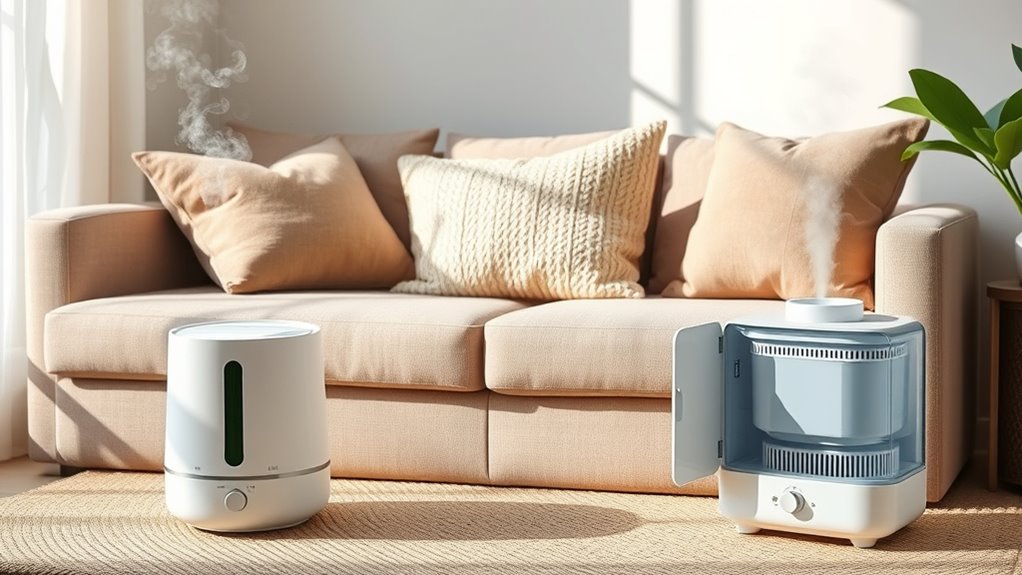
Selecting the right humidifier for your home involves evaluating your specific needs and environment to guarantee ideal comfort and air quality. Consider how important air quality is for your household, especially if anyone has allergies or respiratory issues. Energy efficiency also plays a role, as some units consume less power and save you money long-term. To help decide, review this comparison:
| Feature | Ultrasonic Humidifiers | Evaporative Humidifiers | Best For |
|---|---|---|---|
| Air Quality | Produces finer mist | Uses natural evaporation | Allergies, respiratory health |
| Energy Efficiency | Moderate | Very efficient | Cost-conscious households |
| Noise Level | Very quiet | Slightly louder | Bedrooms, quiet environments |
| Maintenance | Easier cleaning | Needs filter changes | Simplified upkeep |
Choose based on your priorities for air quality and energy savings to find the best fit. Understanding humidity levels can help optimize your choice and ensure a healthier indoor environment.
Frequently Asked Questions
How Do Ultrasonic and Evaporative Humidifiers Impact Allergy Sufferers?
You might find that ultrasonic humidifiers can spread airborne allergens if not cleaned regularly, potentially worsening allergy symptoms. Evaporative humidifiers tend to filter and remove airborne allergens more effectively, improving air quality. For allergy sufferers, choosing an evaporative model can support better air quality and reduce allergen circulation. Regular maintenance is essential regardless of your choice to guarantee ideal air quality improvement and minimize allergen buildup in your home.
Are Ultrasonic Humidifiers Safer for Children and Pets?
You might think ultrasonic humidifiers are safer for children and pets, but that’s not always true. Some emit tiny mineral particles that could irritate sensitive respiratory systems, impacting child safety and pet health. While they produce less noise and are energy-efficient, it’s vital to use distilled water and clean them regularly. Ultimately, choose a device with safety features and maintain it properly to protect your loved ones.
Can These Humidifiers Help Reduce Static Electricity in the Home?
You might notice less static in your home when using humidifiers, as they boost moisture levels and improve air conductivity. By increasing humidity, these devices help reduce static electricity buildup, making static shocks less frequent. Ultrasonic and evaporative humidifiers both contribute to static reduction, but ultrasonic models often deliver finer mist faster. Maintaining proper humidity levels around 40-60% is key to minimizing static electricity effectively.
Which Type Is More Energy-Efficient for Long-Term Use?
When choosing a humidifier, consider energy consumption and maintenance costs for long-term use. Ultrasonic models are generally more energy-efficient, consuming less power, which helps save on electricity bills. They also tend to have lower maintenance costs since they don’t require filter replacements. Evaporative humidifiers may use more energy and need regular filter changes, increasing upkeep. Pick an ultrasonic unit for better efficiency and lower ongoing expenses.
Do Ultrasonic Humidifiers Produce Noise That Might Disturb Sleep?
Like a gentle whisper in a quiet forest, ultrasonic humidifiers often produce low noise levels. You might not notice much noise, but some models can emit a faint hum that could disturb sensitive sleepers. If you’re a light sleeper, you may find this noise causes sleep disturbance. Choosing a quieter model or opting for evaporative humidifiers, which tend to be quieter, can help guarantee your sleep remains peaceful.
Conclusion
So, now that you know the ins and outs of ultrasonic and evaporative humidifiers, you’re practically a humidity expert—ready to pick your perfect match. Whether you prefer whisper-quiet tech or a breeze that’s more “air conditioning” than “mist,” just remember: choosing the right humidifier isn’t rocket science, it’s just about not turning your home into a swamp. Happy humidifying—may your air stay just moist enough to keep your plants happy and your nose from drying out!
